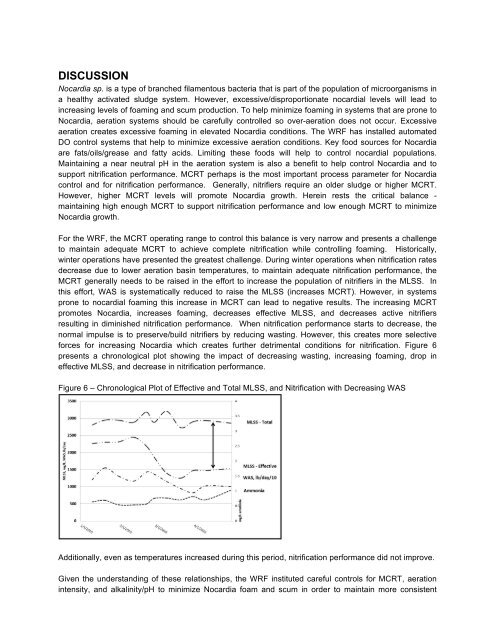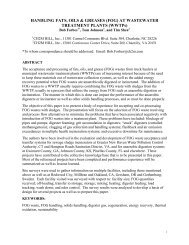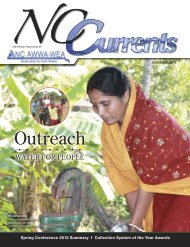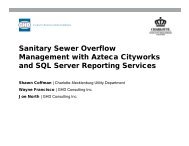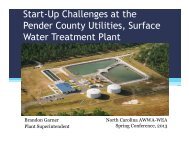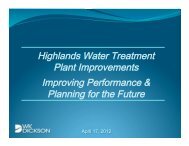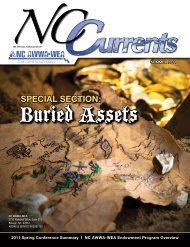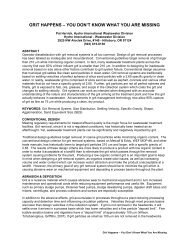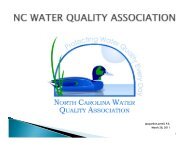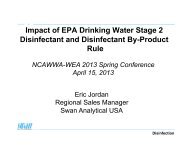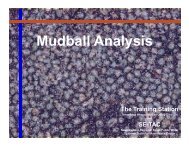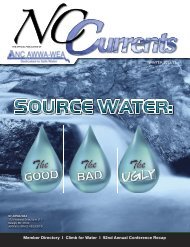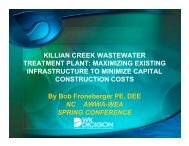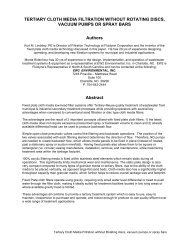NITRIFICATION AND ACTIVATED SLUDGE FOAMING ...
NITRIFICATION AND ACTIVATED SLUDGE FOAMING ...
NITRIFICATION AND ACTIVATED SLUDGE FOAMING ...
You also want an ePaper? Increase the reach of your titles
YUMPU automatically turns print PDFs into web optimized ePapers that Google loves.
DISCUSSION<br />
Nocardia sp. is a type of branched filamentous bacteria that is part of the population of microorganisms in<br />
a healthy activated sludge system. However, excessive/disproportionate nocardial levels will lead to<br />
increasing levels of foaming and scum production. To help minimize foaming in systems that are prone to<br />
Nocardia, aeration systems should be carefully controlled so over-aeration does not occur. Excessive<br />
aeration creates excessive foaming in elevated Nocardia conditions. The WRF has installed automated<br />
DO control systems that help to minimize excessive aeration conditions. Key food sources for Nocardia<br />
are fats/oils/grease and fatty acids. Limiting these foods will help to control nocardial populations.<br />
Maintaining a near neutral pH in the aeration system is also a benefit to help control Nocardia and to<br />
support nitrification performance. MCRT perhaps is the most important process parameter for Nocardia<br />
control and for nitrification performance. Generally, nitrifiers require an older sludge or higher MCRT.<br />
However, higher MCRT levels will promote Nocardia growth. Herein rests the critical balance -<br />
maintaining high enough MCRT to support nitrification performance and low enough MCRT to minimize<br />
Nocardia growth.<br />
For the WRF, the MCRT operating range to control this balance is very narrow and presents a challenge<br />
to maintain adequate MCRT to achieve complete nitrification while controlling foaming. Historically,<br />
winter operations have presented the greatest challenge. During winter operations when nitrification rates<br />
decrease due to lower aeration basin temperatures, to maintain adequate nitrification performance, the<br />
MCRT generally needs to be raised in the effort to increase the population of nitrifiers in the MLSS. In<br />
this effort, WAS is systematically reduced to raise the MLSS (increases MCRT). However, in systems<br />
prone to nocardial foaming this increase in MCRT can lead to negative results. The increasing MCRT<br />
promotes Nocardia, increases foaming, decreases effective MLSS, and decreases active nitrifiers<br />
resulting in diminished nitrification performance. When nitrification performance starts to decrease, the<br />
normal impulse is to preserve/build nitrifiers by reducing wasting. However, this creates more selective<br />
forces for increasing Nocardia which creates further detrimental conditions for nitrification. Figure 6<br />
presents a chronological plot showing the impact of decreasing wasting, increasing foaming, drop in<br />
effective MLSS, and decrease in nitrification performance.<br />
Figure 6 – Chronological Plot of Effective and Total MLSS, and Nitrification with Decreasing WAS<br />
Additionally, even as temperatures increased during this period, nitrification performance did not improve.<br />
Given the understanding of these relationships, the WRF instituted careful controls for MCRT, aeration<br />
intensity, and alkalinity/pH to minimize Nocardia foam and scum in order to maintain more consistent


